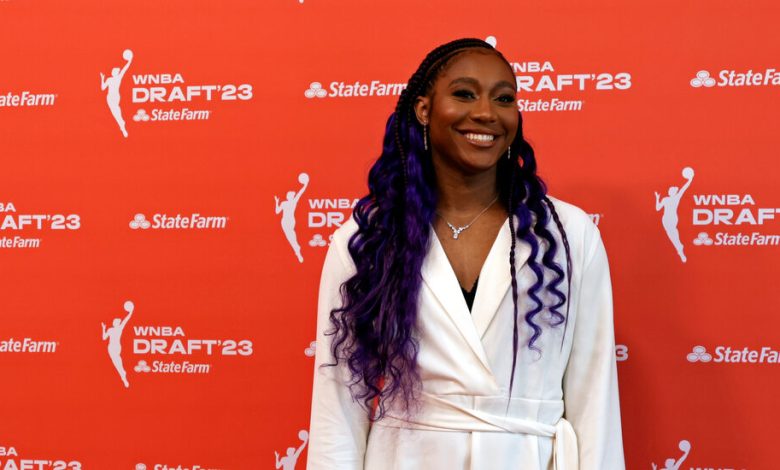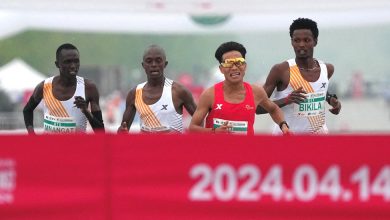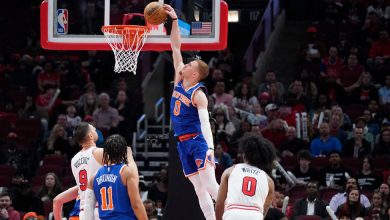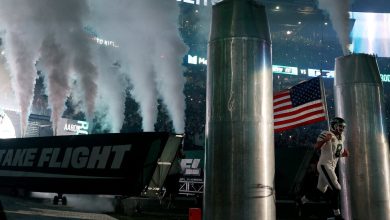W.N.B.A. Draft: Aliyah Boston Goes No. 1 to Indiana Fever

When Aliyah Boston was 12 years old, she took a 1,700-mile journey with her sister to their aunt’s home in Massachusetts from the Virgin Islands, hoping to become a good enough basketball player to go to college for free and maybe one day make it to the W.N.B.A.
Boston fulfilled that dream on Monday night at Spring Studios in New York when the Indiana Fever selected her with the first pick in the W.N.B.A. draft. Boston is the University of South Carolina’s second-ever No. 1 pick in the draft; A’ja Wilson was the first, in 2018.
The selection didn’t come as a surprise, as Boston had been linked with the Fever since they landed the first pick at the draft lottery in November. Boston, a forward, will join a former South Carolina teammate, guard Destanni Henderson, in Indiana.
With Henderson in 2021-22, Boston had the best statistical season of her career, ending it with a national championship win over Connecticut. Boston and Henderson will look to recreate that winning chemistry for the Fever, who have been something of a punching bag for the rest of the league.
Indiana has not made the playoffs since 2016 and has finished with the league’s worst record in the past two seasons. Last season, the Fever finished with five wins; the second-worst team, the Los Angeles Sparks, had 13.
“She’s going to have an immediate impact on this league,” Fever General Manager Lin Dunn said at a predraft news conference on Thursday. “And I’m just thankful — I think we all are — that she opted to come into the draft.”
The Minnesota Lynx took Maryland’s Diamond Miller with the second pick, and the Dallas Wings selected Villanova’s Maddy Siegrist at No. 3.
Boston had been a top player in college basketball since she arrived in South Carolina in 2019. She is a post-scoring, shot-blocking forward who anchored the Gamecocks as they amassed a 129-9 record over her four seasons. Boston was the consensus national player of the year in 2022 and won the Naismith Award for the defensive player of the year in each of her final two seasons.
In her final year, Boston led South Carolina to its first undefeated regular season in program history. Boston’s numbers were down, partly because of South Carolina’s depth and a defensive strategy used by many opponents that made it difficult for her to get loose. The Gamecocks averaged the most bench points per game in Division I in the 2022-23 season with 36.1, almost 5 points per game more than the next closest team.
With Henderson gone, South Carolina never found a reliable scoring guard next to Zia Cooke. So all season, teams sagged off the other guards, daring them to shoot and helping in the paint to deny Boston the ball. That’s a strategy teams can’t employ in the W.N.B.A., because of both the scoring ability of professional guards and the league’s defensive three-second rule, which forbids defenders from standing in the paint for longer than three seconds unless they are within an arm’s length of an offensive player they’re guarding. So Boston will likely see much more 1-on-1 defense and space to roam than she had over her college career.
“I’m really excited for that type of spacing,” Boston said in a recent interview. “Because I think it just shows everyone how they’re able to, you know, just use their talent and go to work.”
For that reason, South Carolina Coach Dawn Staley encouraged Boston to enter the draft this year, after the team lost to Iowa in the Final Four.
“There are defenses that are played against her that won’t allow her to play her game. And then it’s hard to officiate that,” Staley said.
Staley added: “She’s meant everything to our program. She has been the cornerstone of our program for the past four years. She elevated us. She raised the standard of how to approach basketball. She’s never had a bad day.”
Boston still had a year of eligibility remaining, the extra year granted to athletes by the N.C.A.A. due to the coronavirus pandemic. She likely would have been in the conversation for player of the year again, and South Carolina would have been a favorite to win the national title with her back. But perhaps the most significant incentives to stay were the earnings she could have made in college, thanks to rules that allow athletes to make money from their name, image and likeness.
Many women’s basketball players, like Boston, can make more money from collectives and endorsements as college athletes than they can earn from W.N.B.A. salaries alone; the base pay for rookies this season will range from $62,285 to $74,305, depending on the draft round.
That earning potential likely played a role in the decisions of the stars who weren’t at the draft this year. Several eligible players who may have been first-round picks opted to return to college, such as UConn’s Paige Bueckers, Stanford’s Cameron Brink, Virginia Tech’s Elizabeth Kitley, Indiana’s Mackenzie Holmes and U.C.L.A.’s Charisma Osborne. (The W.N.B.A. requires players from the United States to turn 22 years old in the calendar year of the draft.)
That makes next year’s draft all the more exciting. It could be loaded with talent: Angel Reese and Caitlin Clark, the two stars who headlined the Division I women’s tournament with their scoring and showmanship, will be eligible. (Though Reese said on a podcast that she is in “no rush” to go to the W.N.B.A. because she is making more than some top players in the pro league.)
Still, there are only 12 teams and 144 roster spots in the W.N.B.A. Only 36 players are picked in the draft, and only about half of those players typically make an opening day roster. And without a developmental league like the N.B.A.’s G League, some of the best basketball players end up going overseas to play professionally.
“Our top players will not make a pro team,” Arizona Coach Adia Barnes said, adding: “You’re competing against, like, 30-year-old women. It’s hard. It’s competitive.”
Expansion seems like it could be an easy fix to this issue, but W.N.B.A. Commissioner Cathy Engelbert has cited financial concerns for why it’s not possible right now. Engelbert said in February that the league was not in a rush to add new teams but would like to see at least two new teams added in two to four years.
“I’m not going to give a timetable,” Engelbert said on Monday night, adding: “The last thing we want to do is bring new owners in that are going to fail.”
One of the league’s biggest issues has been how teams travel. W.N.B.A. players fly commercial, while most major college programs fly charter. Ahead of Monday night’s draft, the league announced it would offer charter flights for all postseason games and select regular-season games where teams have back-to-back games.
“We intend to do more,” Engelbert said, adding: “We do need some patience and time to build it so that we feel comfortable funding something more substantial as we get into our ensuing years.”



